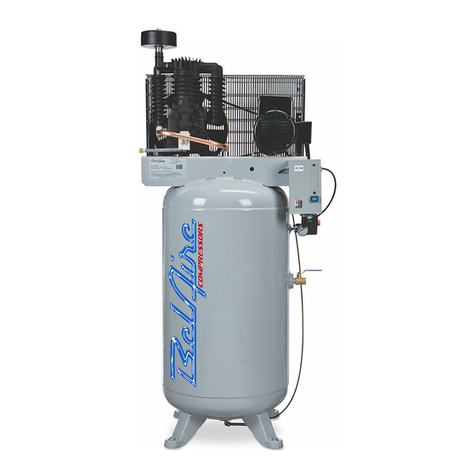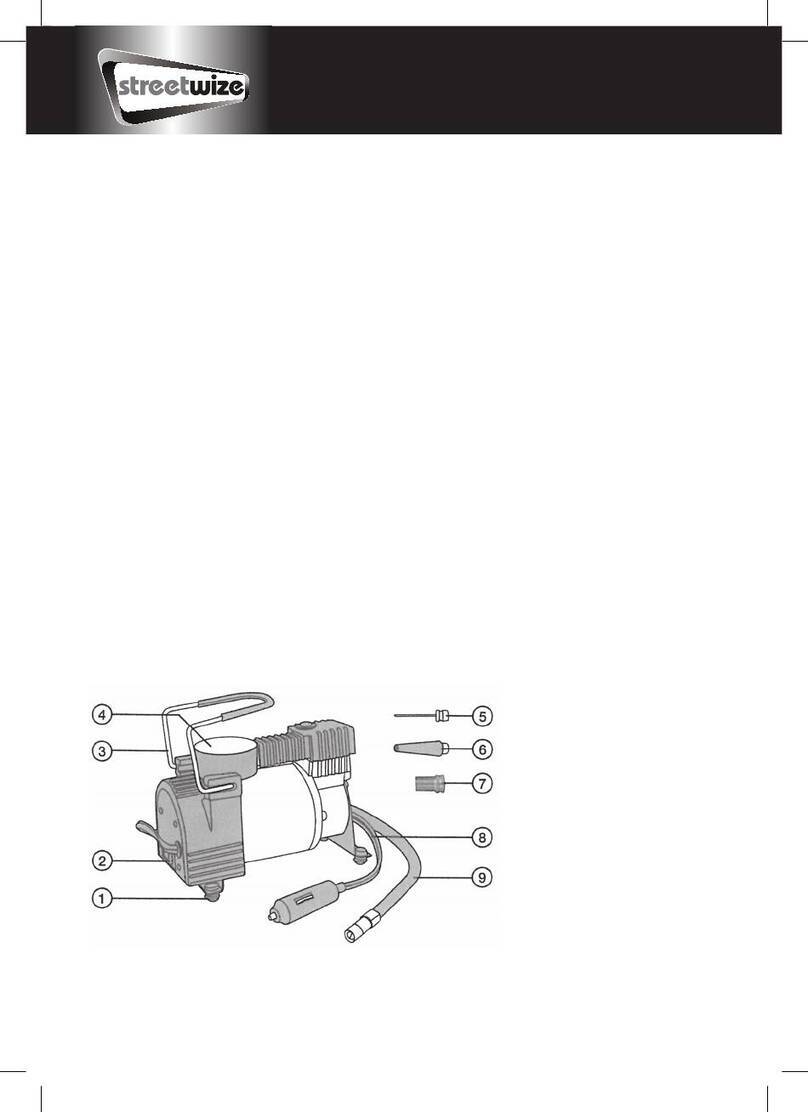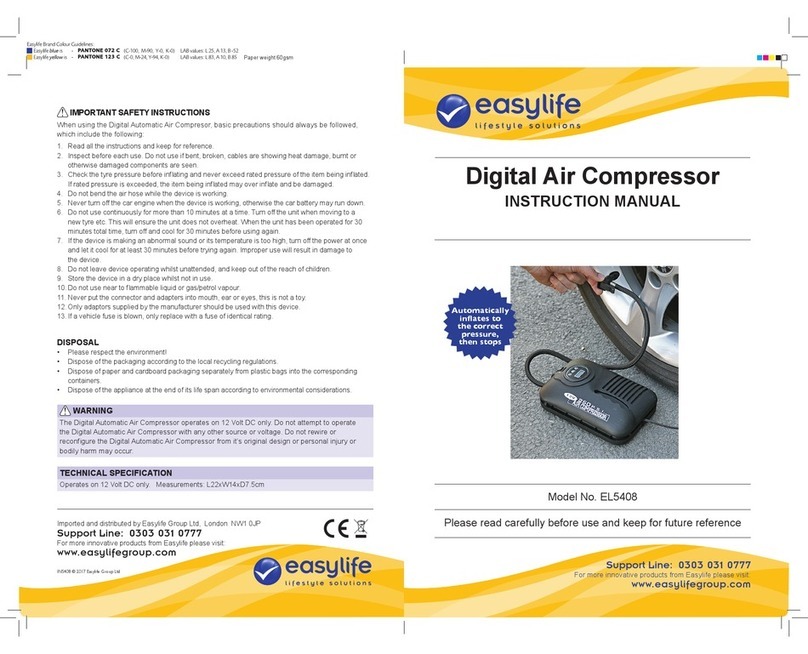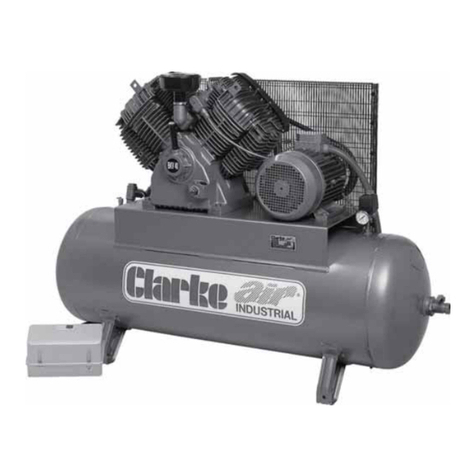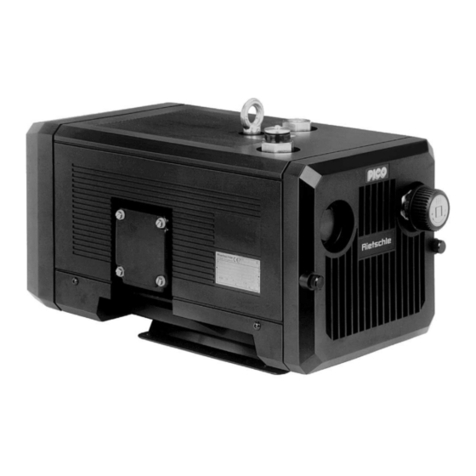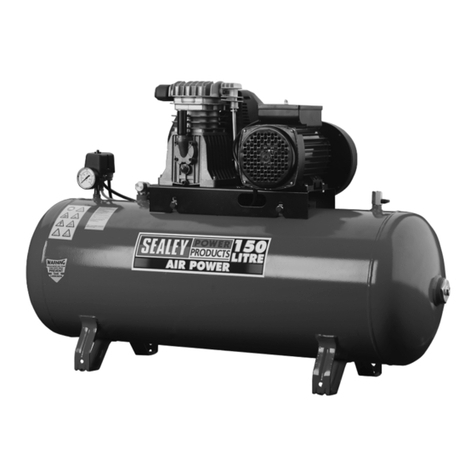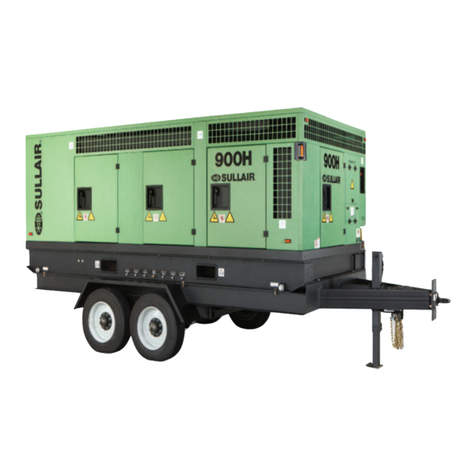BelAire 6312D User manual

For questions concerning this air compressor,
please call 866-869-3114
Part# 1312207701
Air Compressor
Manual
Rev: 0715

TABLE OF CONTENTS
PAGE
1 Safety Guidelines - Definitions
Before Using the Air Compressor
2 When Installing or Moving the Compressor
Before Each Use
3 Follow Safety Precautions for Electrical Connection
Plan Ahead to Protect Your Eyes, Hands, Face & Ears
When Operating
4 Spraying Precautions
Perform These Maintenance Operations
5 Typical Compressor Installation
Glossary
6-9 Wiring
10-11 Starting the Compressor
12 QP Compressor
13-14 Troubleshooting
15 Pump and Tank Specs
16 Tank Warning
17 Parts Reference
18 Single Stage and Contractor
19 Two Stage
20 Gas Drive and Duplex
21 QP
22 Electric Two Stage and Duplex
23-24 PAT24 and PAT38
25 T29S
26 B5900
27 T39
28-29 C1
30-31 C2
Back Warranty Statement

WARNING
Safety is a combination of common sense, staying alert and knowing how your compressor works.
Read this manual to understand this compressor.
CAUTION
DANGER
SAFETY GUIDELINES - DEFINITIONS
means if safety information is not followed someone will be seriously injured or killed
means if safety information is not followed someone may be seriously injured or killed
means if safety information is not followed someone could be seriously injured or killed
IMPORTANT SAFETY INSTRUCTIONS
Save these instructions
Before using the air compressor
Improper operation or maintenance of this product could result in serious injury and property
damage. Read and understand all warnings and operation instructions before using this compressor.
Air compressors are utilized in a variety of air
system applications. Because air compressors
and other components (hoses, connectors, air
tools, spray guns, etc.) make up a high pressure
pumping system, the following safety pre-
cautions should be observed at all times.
Only persons familiar with these rules of
safe operation should use the air
compressor.
1. Read the instruction manual carefully before
attempting to assemble, disassemble or
operate your system. Be thoroughly familiar
with the controls and the proper use of the
equipment.
2. Review and understand all safety instructions
and operating procedures in this manual.
3. Review the maintenance methods for this
compressor (See “Maintaining Your
Compressor” section).
Things you should know Inspect your work area
1. Keep work area clean.
2. Cluttered areas and benches invite accidents.
Floors must not be slippery from wax or dust.
1. To reduce the risk of injury from accidental
starting, turn switch off and disconnect the
power before checking it.
2. If any part is missing, bent or broken in any
way, or any electrical part does not work prop-
erly, keep the compressor off and disconnected.
3. Check hoses for weak or worn condition
before each use, making certain all connections
are secure. Do Not use if defect is found.
Do not operate compressor if damaged during
shipping, handling or use. Damage may result
in bursting and cause injury or property damage.
This compressor is Not designed for and should
not be used in breathing air applications.
Inspect your compressor
WARNING
Page 1
DANGER

Page 2
This compressor is extremely top heavy. The
compressor must be bolted to the floor with
vibration pads before operating to prevent
equipment damage, injury or death. Do Not
tighten bolts completely as this may
cause stress to the tank welds. Chart 1a.
To reduce the risk of a dangerous
environment
1. Keep work area well lit.
2. Operate compressor in a well-ventilated
area free from flammable liquids and vapors.
3. Operate compressor in a ventilated area so
that compressor may be properly cooled and
the surrounding air temperature will not be
more than 100°F.
4. Never use a compressor in a wet
environment.
5. Protect material lines and air lines from
damage or puncture. Keep hose and
wires away from sharp objects, chemical
spills, oil, solvents and wet floors.
Do Not secure compressor with toggle bolts
into drywall. Drywall sheeting or plaster will not
support the weight of the compressor.
WARNING 6. A minimum clearance of 18 inches between
the compressor and a wall is required
because objects could obstruct airflow.
7. The compressor should be located where it can
be directly wired to a circuit breaker. The
compressor should be wired by a qualified
electrician.
8. Never store flammable liquids or gases in
the vicinity of an operating compressor.
9. Do Not locate the compressor air inlet near
steam, paint spray, sandblasting areas or
any other source of contamination. The
debris could damage the motor and pump.
Never use plastic (PVC) pipe for compressed
air. Serious injury or death could result.
Never use the shipping skid for mounting the
compressor.
Electric Compressors are not suitable for
outdoor installation.
Gasoline Compressors must be operated
outdoors, sheltered from the weather.
Never install a shut off valve between the
compressor pump and tank. Personal injury
and/or equipment damage could occur.
WARNING
CAUTION
NOTICE
WARNING
WARNING
Before each use
1. Keep work area clean. Cluttered areas and
benches invite accidents.
2. The floor must not be slippery from wax or
dust.
1. To reduce the risk of injury from accidental
starting, turn the switch off and disconnect
power.
2. If any part is missing, bent or broken in any
way, or any electrical part does not work
properly, keep the compressor off and dis-
connect power. Do Not use if defect is found.
3. Check hoses for weak or worn condition
before each use, making certain all connect-
ions are secure. Do Not use if a defect is
found.
Inspect your work area Inspect your compressor
Always Shut Off Gas Valve before
moving Gas Drive Compressors
Chart 1a
Vibration Pad
Compressor
Leg
Lag Bolt
Floor
Flat
Washer
Shim
(If Necessary)
NOTICE
When installing or moving the compressor

Follow the safety precautions for electrical connections
Page 3
WARNING
CAUTION
WARNING
Plan ahead to protect your eyes, hands, face and ears
1. Wear safety glasses (meeting ANSI Z87.1 or
in Canada CSA Z94.3-99) and use hearing
protection when operating the unit. Everyday
glasses are not safety glasses.
2. Wear shoes to prevent shock hazards.
3. Tie back long hair.
Keep fingers away from running compressor.
Fast moving and hot parts may cause injury
and/or burns.
1. Follow all local electrical and safety codes,
as well as the National Electric Code (NEC)
and the Occupational Safety and Health
Act (OSHA).
2. Wiring and fuses should follow electrical
codes, current capacity and be properly
grounded.
3. Protect wires from contact with sharp objects.
All electrical connections should be made by
a qualified electrician.
Dress for safety
Be careful when touching the exterior of comp-
ressor, pump, motor and air lines; they may
become hot enough to cause injury.
Never operate the compressor without a
beltguard. The compressor can start auto-
matically without warning. Personal injury or
property damage could occur from contact
with moving parts.
The compressor may be hot even if the unit is
stopped.
Use of a mask or respirator per chemical
manufacturers’ instructions may be neces-
sary if there is a chance of inhaling toxic fumes.
Read mask and respirator instructions care-
fully. Consult a safety expert if you are not
sure about the use of certain masks or
respirators.
Pay attention to your hands
WARNING
CAUTION
WARNING
When operating
1. Do not exceed the pressure rating of any
component of the system.
2. Release pressure within the system slowly
to prevent flying dust and debris.
3. If the equipment starts to abnormally vibrate,
STOP the compressor immediately and
check for the cause.
WARNING
Never change the safety valve or pressure
switch settings. Keep safety valve free from
paint and other accumulations. See compressor
specification decal for maximum operating
pressure. Do not operate with the pressure
switch set higher than the maximum operating
pressure.

Spraying precautions
Page 4
Perform these maintenance operations
1. Do Not spray in the vicinity of open flames
or other places where a spark can cause
ignition. Do Not smoke when spraying
paint, insecticides, or other flammable
substances.
1. When spraying with solvents or toxic chemi-
cals, follow the instructions provided by the
chemical manufacturer. Consult a safety
expert if unsure about the use of masks or
respirators.
2. If the material you intend to spray contains
trichloreoethane and methylene chloride, do
not use accessories that contain aluminum or
galvanized materials, as these chemicals can
react with galvanized components causing
corrosion and weakening equipment. Use
stainless steel accessories.
WARNING
Never point a spray gun at yourself or any
other person or animal. Accidental discharge
may result in serious injury.
Reduce the risk of dangerous
environment
WARNING
Extreme caution should be taken when
spraying flammable liquids as the spark from
a motor or pressure switch may cause a fire
or explosion. Ample ventilation must be
provided.
WARNING
Spray in a well ventilated area to keep fumes
from collecting and causing serious injury and
fire hazards.
Be informed about the materials you use
1. Do regular maintenance; keep all nuts, bolts,
and screws tight, to be sure equipment is in
safe working condition.
2. Inspect tank yearly for rust, pin holes or any
other imperfections that could cause it to
become unsafe.
NEVER attempt to repair or modify a tank!
Welding, drilling or any other modification will
weaken the tank resulting in damage from
rupture or explosion. Always replace worn,
cracked or damaged tanks.
3. Clean electrical equipment with an approved
cleaning agent, such as a dry, non-flam-
mable cleaning solvent.
Daily
Check oil level at sight glass. Oil level should
be 1/2 to slightly higher in the oil sight glass.
Drain moisture from tank.
Verify the pressure switch unloader is
working by listening for a brief hissing sound
when the compressor shuts off.
Visually check the compressor for loose parts,
excessive noise or vibration. Tighten any
necessary part.
WARNING
4. Drain tanks of moisture after each day’s use.
If unit will not be used for awhile, it is best to
leave the drain cock open until such time as it
is to be used. This will allow moisture to
completely drain out and help prevent
corrosion of inside of tank.
5. Always disconnect from power source before
working on or near a motor, or its connected
load. If power disconnect point is out-of-
sight, secure it in the “OFF” position and tag it
to prevent unexpected application of power.
Disconnect power and depressurize system
before servicing air compressor. Slightly open
drain cock after shutting off compressor.
Monthly
(Make sure the main power is off.) Check the belts
for tension. Belts should not move up and down
when the compressor runs and when stopped,
should not have more than ½ in of play when
depressed. Be careful not to over tighten belts
during adjustment.
Remove and check air filter, replace if necessary.
Change oil every 3 months or 300 hours. A
compressor grade 30 wt non-detergent oil should
be used. 40 wt non-detergent for single stage.
WARNING

Page 5
WIRING
TYPICAL COMPRESSOR INSTALLATION
GLOSSARY OF TERMS
Air Filter
Porous element contained within a metal or
plastic housing attached to the compressor
cylinder head which removes impurity from the
intake air of the compressor.
Air Tank
Cylindrical component which contains the
compressed air.
Check Valve
Device which prevents compressed air from
flowing back from the air tank to the compres-
sor pump.
Electric Motor
Device which provides the rotational force
necessary to operate the compressor pump.
Pressure Gauge
Device which shows the tank or regulated
pressure of the compressed air.
Pressure Switch
Device which automatically controls the on/off
cycling of the compressor. It stops the
compressor when the cut-off pressure in
the tank is reached and starts the compressor
when the air pressure drops below the cut-in
pressure.
PSI (Pounds per Square Inch)
Measurement of the pressure exerted by the
force of air. The actual psi is measured by a
pressure gauge on the compressor.
Pump
Device which produces the compressed air
with a reciprocating piston contained within a
cylinder.
Safety Valve
Device which prevents air pressure in the air
tank from rising over a predetermined limit.
Thermal Overload Switch
Device, integrated into the electric motor winding,
which automatically “shuts off” the compressor
if the temperature of the electric motor exceeds
a predetermined limit.
Flex
Hose
Air
Dryer
To Air System
Vibration Pads
Regulator
Chart 1a
Vibration Pad
Compressor
Leg
Lag Bolt
Floor
Flat
Washer
Shim
(If Necessary)
See Illustration 1a

To reduce the risk of electrical hazards, fire
hazards or damage to the compressor, use
proper circuit protection. Your compressor
is wired at the factory for operation using
the voltage shown. Connect the compressor
to a power source with the correct breaker
size.
Adequate wiring and motor protection
should be provided for all stationary
compressors. Wiring used for other
machinery should not be used. A
qualified electrician familiar with local
electrical codes in your area should be
used. Size supply wiring per NEC (National
Electric Code) requirements.
WIRING
ALL ELECTRICAL WIRING SHOULD BE DONE
BY A QUALIFIED ELECTRICIAN
General Information
Electrical connections must be properly
grounded. Ground connections should be
connected at the grounding screw.
WARNING
WARNING
WARNING
Overheating, short circuiting and fire damage
will result from inadequate wiring.
CAUTION
WIRING
Single Phase
Incoming power should
be connected to L1 and
L2 at the Top of the
Magnetic Starter.
Duplex Wiring
(Inside Controller on the Bottom)
Incoming power
should be
connected to
L1, L2 & L3 at
the Top of the
Magnetic Starter.
DO NOT MAKE CONNECTIONS
AT THE PRESSURE SWITCH
(Units with Magnetic Starters)
For Models Without Magnetic Starter
Incoming power
should be connected
to the posts
marked (LINE)
Do Not Make
Connections On
Prewired Posts
Marked (MOTOR)!
Electrical connections
must be properly
grounded. Ground
connections should be
connected at a
grounding screw.
Page 6
Overload
Adjustment
+
-
Single Phase
Three Phase
Three Phase

WIRING
WIRING
Single and Three Phase
With Mag Starter
Page 7

WIRING
WIRING
Page 8
Single and Three Phase
Duplex

WIRING
WIRING
Single and Three Phase
QP
Page 9

(Duplex Models)
STARTING THE COMPRESSOR
Prior to actually running the compressor,
check the following items:
Crankcase oil - Make sure the sight glass
shows ½ full or slightly above.
Make sure all rags, tools, oil, etc. are away
from the unit.
Open the air system to free it of any pressure.
Switch the compressor on for a few
revolutions to make sure the rotation is
correct. Correct rotation is clockwise
when facing the sight glass on the pump.
Operate the compressor for a few minutes
unloaded (air system open) then allow the
compressor to pump up. Make sure the
electrical pressure switch properly switches
off the compressor according to the setting
desired. 175 for Two Stage.
(135 psi - Single Stage or 165 psi - RCP-561VNS)
Make sure the pressure in the tank does
not exceed its rating. Single Stage units - 135 psi
Two Stage units at a maximum of 175 psi.
(165 for Model RCP-561VNS)
If the pressure gauge indicates a pressure that
is higher than these maximum pressures,
shut off compressor immediately and call
your distributor.
STARTING THE COMPRESSOR
CAUTION
Page 10
Alternating Running Procedure
Initial power to the controller takes about 5 seconds to power up and run
Motor A will start and then Motor B after a 10 second delay
Both motors will run until unit reaches cutoff pressure (175 psi)
Each time the unit starts after initial start, the “Lead” motor will alternate
If the unit runs for more than 5 minutes, the second Motor will come on and run
until the unit reaches cutoff pressure
The second motor will also come on if the air demand is higher than one pump/
motor can produce and the pressure drops to around 135 psi (10 sec. delay)
A or B Running Procedure
By selecting A or B on the switch, either Pump/Motor A or Pump/Motor B will
operate independently, as a simplex compressor.
Normal
Operation

· Release any remaining tank pressure by slowly opening the
manual drain valve.
· Turn on the engine gasoline supply.
· Put the choke in the “On” position
· Close the service valve and put Unloader lever in the “unload”
(A) position for Briggs and Stratton and Honda engine driven
models, or the “load” (B) position for Kohler engine models.
· Start the engine, release the choke, and allow the engine to
warm up for two to three minutes.
· Return the unloader lever to the “load” (B) position on Briggs
and Stratton and Honda driven models.
Note: Turn the gasoline supply off when the compressor is
not being used
Cold Start Procedure (Gasoline Engine Units)
Warning: Do Not Operate Gasoline Engine
Units in an Enclosed Area
Page 11
Note:Make sure to follow instructions carefully to avoid a short and possible damage
to the starter solenoid and/or battery.
1. Connect the positive (+) terminal on the battery to the starter solenoid.
2. Connect the negative (-) terminal on the battery to an engine mounting bolt or other
acceptable ground connection.
Always connect the positive(+) battery cable to the starter solenoid before connecting
the negative(-) battery cable.
NUMBER 2 WIRE OR LARGER IS REQUIRED
(Gas Drive Models)
Battery Connection Instructions for Electric Start Engines
PLEASE REFER TO YOUR ENGINE OPERATION MANUAL FOR PROPER STARTING
INSTRUCTIONS.
GASOLINE DRIVEN COMPRESSORS ARE EQUIPPED WITH A COLD START
VALVE FOR LOADLESS STARTS.
NOTE: IN SOME INSTANCES, IT STILL
MAY BE NECESSARY LIFT THE TOGGLE ON THE UNLOADER/PILOT VALVE
TO RELIEVE THE HEAD PRESSURE. See Page 11
BATTERY
(12 Volt)
(+)(-)
GROUND
Starter Solenoid

QP Compressors
BelAire ELITE and QP models come equipped with low oil level switches and automatic tank
drains. The QP models also include protection against over-heating.
Page 12
Low Oil Level Switch
OIL
Target Oil Level
Oil Vent
Plug
The function of the low oil level switch
is to keep the air compressor from
starting if the oil level drops beyond
a certain point.
For compressors outfitted with the
low oil level switch, the oil should
in the top 1/3 of the oil sight glass.
When changing or adding oil, it is
important to remove the Oil Vent
Plug to allow for the oil to flow
completely into the switch.
(Please Note: If overfilled, oil will flow out
of the oil vent hole)
Thermal Protection - QP Models
If the cooling fan were to fail or
internal temperature were to reach
180°F the QP models are outfitted
with a thermal fuse.
When tripped, the fuse can be reset.
The canopy will need to be removed
to reset the thermal fuse.
Location of Fuse
(Inside Canopy
Behind Fan)
Press to
Reset
You have purchased a state of the art BelAire QP compressor. The QP comes equipped
with sound attenuating enclosure. For maintenance, the canopy and side foam pieces will need
to be removed.
To remove the canopy, simply remove the 6 fasteners and lift the canopy straight up and off.
QP and Elite Compressors

Page 13
!
DANGER
Low discharge pressure 1. Reduce air demand or use a compressor
with more air capacity.
2. Listen for air leaks. Apply a soap solution
to all fittings and connections. Bubbles
will form at points of leakage. Tighten
or replace fittings or connections.
3. Clean or replace air filter.
4. Replace necessary gaskets.
5. Remove head and inspect for broken or
misaligned valves. Replace valves, if
necessary.
Install a new head gasket
each time head is removed
1. Tighten drive pulley or flywheel bolt.
2. Check for proper oil level. Low or dirty
oil may cause bearing damage.
3. Replace connecting rod and/or connecting
rod bearings.
4. Replace check valve.
with air pressure in tank
1. Replace with new piston rings.
2. Clean or replace air filter.
3. Drain oil to proper oil level.
4. Use a quality non-detergent 30 or 40wt
oil specified for each model (Page 4).
1. Drain tank at least once per day.
2. Add an inline filter to reduce moisture in
the air line.
1. Check voltage with volt meter across both
legs of incoming power. Check reset button
on motor.
2. Repair or replace pressure switch.
3. Replace check valve or pressure switch.
Do not remove check valve
with air pressure in tank
1. Make sure the breaker is sized properly.
See page 6 in this manual.
2. Check voltage with volt meter across both
legs of incoming power.
3. Replace motor.
4. Check all electrical connections.
5. Adjust or replace pressure switch.
6. Replace check valve.
Do not remove check valve
with air pressure in tank
1. Replace check valve.
Do not remove check valve
with air pressure in tank
2. Tighten or replace fittings or connections.
3. Replace tank. Do not attempt to repair tank.
Do not remove check valve
1. Compressor too small for
application
2. Air leaks
3. Restricted intake air
4. Blown gasket(s)
5. Broken or misaligned valves
!
DANGER
!
DANGER
!
DANGER
1. Loose drive pulley or flywheel
2. Low on oil
3. Worn connecting rod or
connecting rod bearing
4. Noisy check valve
1. Worn piston rings
2. Restricted intake air
3. Too much oil in compressor
4. Incorrect oil viscosity
1. Normal. Amount of water will
increase as humidity in the
air increases.
1. Low voltage
2. Malfunctioning pressure switch
3. Malfunctioning check valve
1. Incorrect breaker size
2. Low voltage
3. Malfunctioning motor
4. Loose electrical connections
5. Malfunctioning pressure switch
6. Malfunctioning check valve
Tank does not hold
pressure when not
running and shut off
valve is closed
Breaker or reset
repeatedly trips
Will not run or motor
hums
Water in tank and/or
discharge line
Excessive oil carryover
Excessive noise
“knocking”
TROUBLESHOOTING GUIDE
1. Malfunctioning check valve
2. Loose fittings or connections
3. Crack or pin hole in tank
CAUTION
!

Page 14
1. Replace pressure switch if it does not release
air pressure briefly when unit shuts off.
Do not remove pressure
switch with air pressure in
tank
1. Make sure unit is mounted on a level surface
with vibration pads.
2. Replace belts. Align and tighten properly.
3. Align flywheel and drive pulley.
1. Reduce air demand or use a compressor
with more air capacity.
2. Clean all cooling surfaces of dirt and dust.
3. Install compressor in an area with adequate
cool dry air.
1. Malfunctioning check valve
Overheating
TROUBLESHOOTING GUIDE (Continued)
Pressure switch un-
loader constantly
leaking air
1. Replace check valve if unloader bleeds
constantly.
Do not remove check valve
with air pressure in tank
!
DANGER
Pressure switch not
unloading
1. Malfunctioning pressure
switch
!
DANGER
Excessive vibration
1. Compressor too small for
application
2. Cooling surfaces dirty
3. Improper cooling
1. Improper installation
2. Loose belts
3. Misaligned flywheel or
drive pulley

PAT24 4116091136 2 1
PAT38 4116091337 2 1
T39 4116090019 2 2
T29S 4116090112 2 2
B5900 4116090137 2 2
C1 1312202800 2 2
C2 1312202700 4 2
Pump
Model Pump P/N Cyl. No. Stages
WIRING
Pump Specifications
WIRING
Tank Specifications
Volume Max Pressure Discharge Conn.
Gal. Liter PSI Bar NPT
20H 76 150 10.345 1/4"
26V 99 150 10.345 1/4"
60V 228 170 11.724 1/2'
2X4 2X15.2 200 13.793 3/8"
2X5 2X19 200 13.793 3/8"
80H 228 200 13.793 3/4"
80V 300 200 13.793 3/4"
30H 114 200 13.793 3/4"
120V 456 200 13.793 3/4"
120H 456 200 13.793 3/4"
120D 456 200 13.793 3/4"
200D 760 200 13.793 3/4"
Page 15
Conrod Head Cylinder Bearing Housing Flywheel
PAT24 N/A 18-20 (24-27) 18-20 (24-27) 5-7 (7-10) 18-20 (24-27)
PAT38 N/A 18-20 (24-27) 18-20 (24-27) 5-7 (7-10) 18-20 (24-27)
T39 20-22 (27-30) 30-33 (40-45) 16-19 (22-26) 19-22 (26-30) 34-37 (46-50)
T29S 18-20 (24-27) 18-20 (24-27) 18-20 (24-27) 5-7 (7-10) 18-20 (24-27)
B5900 18-20 (24-27) 18-20 (24-27) 18-20 (24-27) 5-7 (7-10) 18-20 (24-27)
C1 34-37 (46-50) 34-37 (46-50) 19-27 (26-37) 14-19 (19-26) 47-57 (64-77)
C2 34-37 (46-50) 34-37 (46-50) 19-27 (26-37) 14-19 (19-26) 47-57 (64-77)
Pump
Model
Bolt Torque Ft.-Lbs. (NM)
1st Stg 2nd Stg CFM L/M
PAT24 2.48 (63) N/A 1.50 (38) 1400 .56 (0.53 ) 11.71 331.59
PAT38 2.48 (63) N/A 2.36 (60) 1400 .91 (.86) 18.49 523.58
T39 4.13 (105) 2.05 (52) 2.95 (60) 1400 1.09 (1.03) 32.02 906.63
T29S 3.74 (85) 1.97 (45) 1.97 (45) 1400 1.44 (1.36) 17.53 496.50
B5900 4.13 (105) 2.16 (55) 2.16 (55) 1400 1.72 (1.63) 23.44 663.84
C1 4.13 (105) 2.16 (55) 3.5 (89) 1000 1.31 (1.24) 27.13 768.33
C2 4.13 (105) 2.16 (55) 3.5 (89) 900 1.5 (1.42) 48.84 1382.99
Pump
Model
Cyl. Diam. In. (mm) Displacement @ max RPM
Max rpm
Stroke in.
(mm)
Oil Cap.
Qt. (L)

Do not open a manual tank drain valve on any air tank containing
more than 30 PSIG of air pressure!
Never attempt to releive an air tank by removing a pipe plug or
any other system component!
Manually Draining An Air Tank:
Step 1)
Disconnect & lockout the compressor from the power source (elec
tric models) or disconnect the spark plug wire from the spark plug
(gas engine models).
Step 2)
Tank(s) subjected to freezing temperatures may contain ice. Store
the compressor in a heated area before attempting to drain mois
ture from the tank(s). Reduce the air pressure in the tank to 30
PSIG by pulling the pressure relief valve ring (refer to Fig. 3-4,
Checking Pressure Relief Valves & Relieving System Pres
sure ).
Step 3) Slowly open the drain valve and allow the moisture and air mixture
to drain from the tank.
Step 4) Once the moisture has been completely drained, close the drain
valve.
Oil and moisture residue must be drained from the air receiver
daily or after each use. Accumulations of oil residue in the receiver
can be ignited by embers of carbon created by the heat of compression
causing an explosion, damage to property and injury to personnel
-
WARNING
WARNING
WARNING
The factory recommends that all
air tanks be inspected at scheduled inter
vals. Refer to Recommended Air
Tank Inspection Intervals Table
relative information.
Refer to federal, state or provincial,
or local codes for mandatory air tank
-
for
maintenance information.
Page 16
Air Tank Inspection
Recommended Air Tank Inspection Intervals
HEAD SHELL
8 Gal. Horizontal 0.096 0.094 Yearly 10 Years
8 Gal. Twin Horz. 0.098 0.098 Yearly 10 Years
10 Gal. Twin Horz. 0.118 0.118 Yearly 10 Years
20 Gal. Horizontal 0.094 0.094 Yearly 10 Years
26 Gal. Vertical 0.094 0.094 Yearly 10 Years
30 Gal. Horizontal 0.109 0.098 Yearly 10 Years
60 Gal. Vertical 0.094 0.094 Yearly 10 Years
80 Gal. Vertical 0.149 0.133 Yearly 10 Years
80 Gal. Horizontal 0.109 0.133 Yearly 10 Years
120 Gal. Vertical 0.163 0.199 Yearly 10 Years
120 Gal. & Duplex Horizontal 0.131 0.159 Yearly 10 Years
200 Gal. Duplex Horizontal 0.163 0.199 Yearly 10 Years
Tank Capacity
Horizontal
or
Vertical
Minimum
Allowable Wall Visually
Inspect
HydrostaticallLJ
Inspect

Part Callouts
Compressor
Motor
Tank
Check Valve
Pressure Switch
Discharge Line
Ball Valve
Inlet Filter
Water/Tank Drain
Compressor
Engine
Tank
Pressure Gauge
Inlet Filter
Water/Tank Drain
Pilot/Unloader Valve
Idle Control
Drive Belt
Belt Guard
Drive Belt
Magnetic Starter
Pressure Gauge
Ball Valve
Electric
Gas Drive
Page 17

Single Stage
Contractor
Page 18
*Note: Verify Model and Part Number of Machine Before Ordering
Change has been made to Compressor Pumps (March-April 2014)
*Model 5020P (Part# 8090254163)
Model 5026VP (Part# 8090254106)
Model 2061V (Part# 8090254064)
Model 6061V (Part# 8090254007)
*Model T2030 (Part# 8090254239)
*Model TH5530 (Part# 8090254262)
Model TR6030 (Part# 8090254296)
5020P* 5026VP* 2061V* 6061V*
Compressor
4116091336 4116091336 4116091337 4116091337
Motor 1312100388 1312100388 1312100388 1312100390
Tank 1312100473 1312100475 1312100460 1312100460
Check Valve 1312100170 1312100170 1312100170 1312100170
Pressure Switch 1312100455 1312100455 1312100455 1312100455
Safety Valve 1312100005 1312100005 1312100005 1312100005
Pressure Gauge 1312100006 1312100006 1312100840 1312100840
Discharge Line 1312101048 1312101048 1312101047 1312101047
Inlet Filter 2236111635 2236111635 2236111635 2236111635
Tank Drain 1312100360 1312100360 1312100360 1312100360
BeltGuard (front) 6214343100 6214343100 6214343100 6214343100
BeltGuard (back) 2236110472 2236110472 2236110472 2236110472
Drive Pulley 1312100439 1312100439 1312101154 1312101070
Drive Belt 1312101067 1312101067 1312100132 1312100807
Unloader Line 1312100026 1312100026 1312100026 1312100026
Power Cord 1312100007 1312100007 N/A N/A
Wheel 1312100060 1312100029 N/A N/A
Handle 2236107285 2236107294 N/A N/A
ELECTRIC
T2030
Compressor 4116091337
Motor 1312100388
Tank 1312100521
Check Valve 1312100170
Pressure Switch 1312100455
Safety Valve 1312100005
Pressure Gauge 1312100845
Discharge Tube 1312101156
Ball Valve 1312100161
Inlet Filter 2236111635
Tank Drain 1312100360
Unloader Line 1312100026
BeltGuard 1312101096
Drive Pulley 1312101154
Drive Belt 1312100129
Wheel 1312100461
Power Cord 1312100007
GAS DRIVE
TH5530 TR6030 TR908 TH908 TK128-I
Compressor 4116091337 4116091337 4116090019 4116090019 4116090019
Engine 1312100219 1312100230 1312100231 1312100221 1312101114
Tank 1312100521 1312100521 1312100520 1312100520 1312100520
Idle Control 1312100382 1312100382 1312100382 1312100382 1312100571
Unloader/Pilot Valve 1312100496 1312100496 1312100495 1312100495 1312100495
Safety Valve 1312100005 1312100005 9710533300 9710533300 9710533300
Pressure Gauge 1312100845 1312100845 1312100845 1312100845 1312100845
Discharge Tube 1312101160 1312101160 1312100204 1312100204 1312100204
Ball Valve 1312100161 1312100161 1312100161 1312100161 1312100161
Inlet Filter 2236111635 2236111635 1312100374 1312100374 1312100374
Tank Drain 1312100360 1312100360 1312100360 1312100360 1312100360
Belt Guard 1312101096 1312101096 1312101144 1312101144 1312101144
Drive Pulley 1312101070 1312101070 1312100419 1312100419 1312100419
Drive Belt 1312100131 1312100131 1312100136 1312100137 1312100136
Wheel 1312100461 1312100461 1312100461 1312100461 1312100461
This manual suits for next models
9
Table of contents
Other BelAire Air Compressor manuals
Popular Air Compressor manuals by other brands
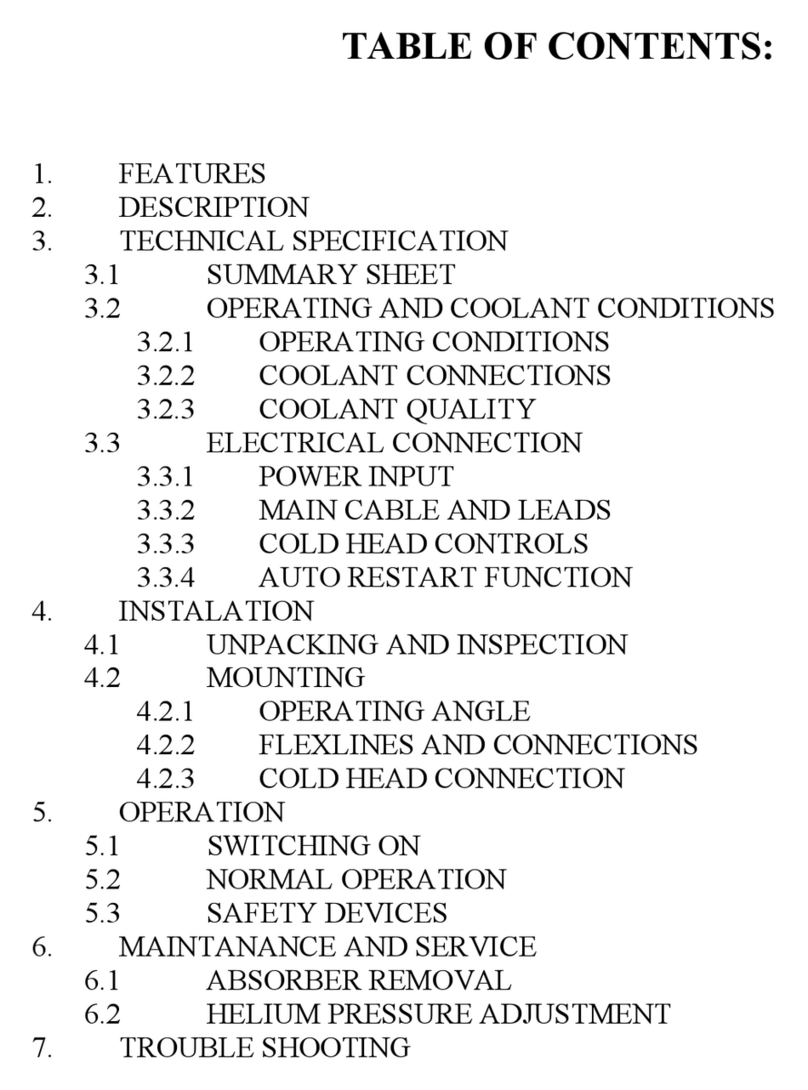
AUSTIN SCIENTIFIC
AUSTIN SCIENTIFIC M600 manual
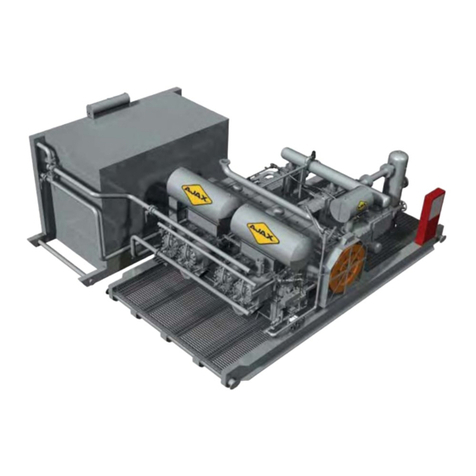
GE
GE Ajax DPC 2804 LE Operation & maintenance manual
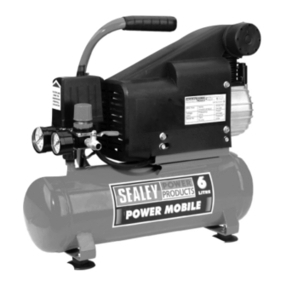
Sealey
Sealey SA2306 instruction manual
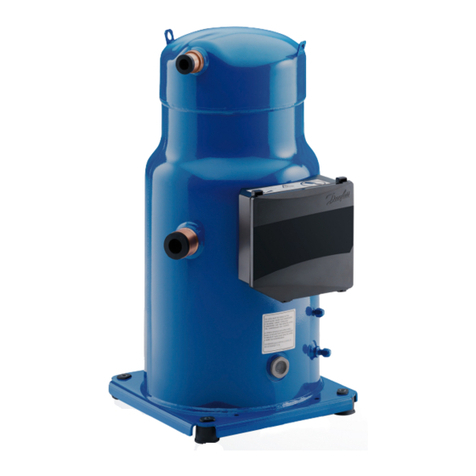
Danfoss
Danfoss Performer SH090 Application guidelines
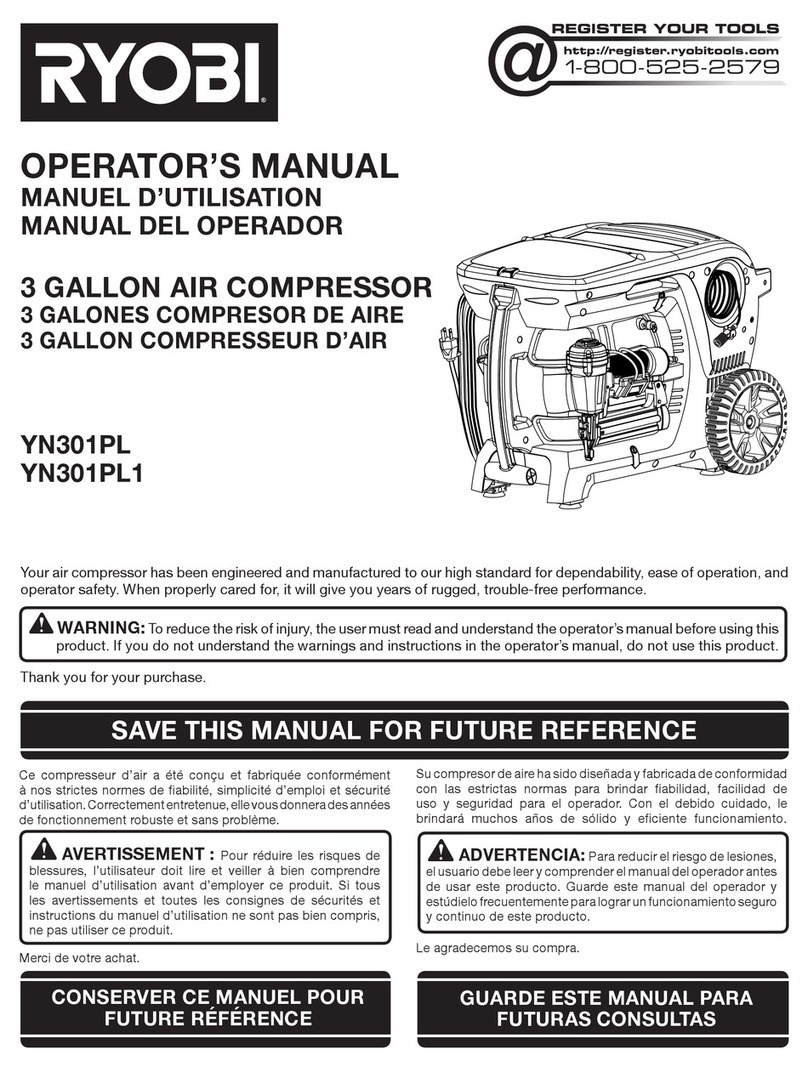
Ryobi
Ryobi YN301PL1 Operator's manual
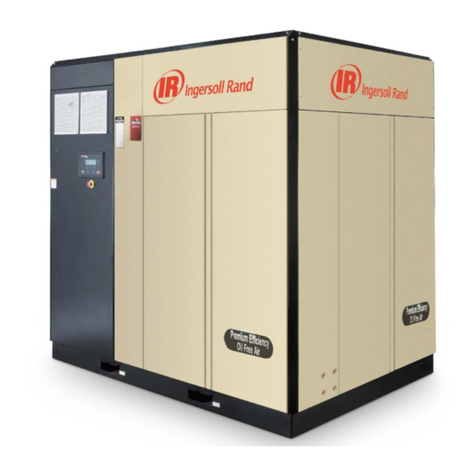
Ingersoll-Rand
Ingersoll-Rand NIRVANA IRN37K-OF Operation and maintenance manual

EKOM
EKOM DK50 9x4VRT/M user manual
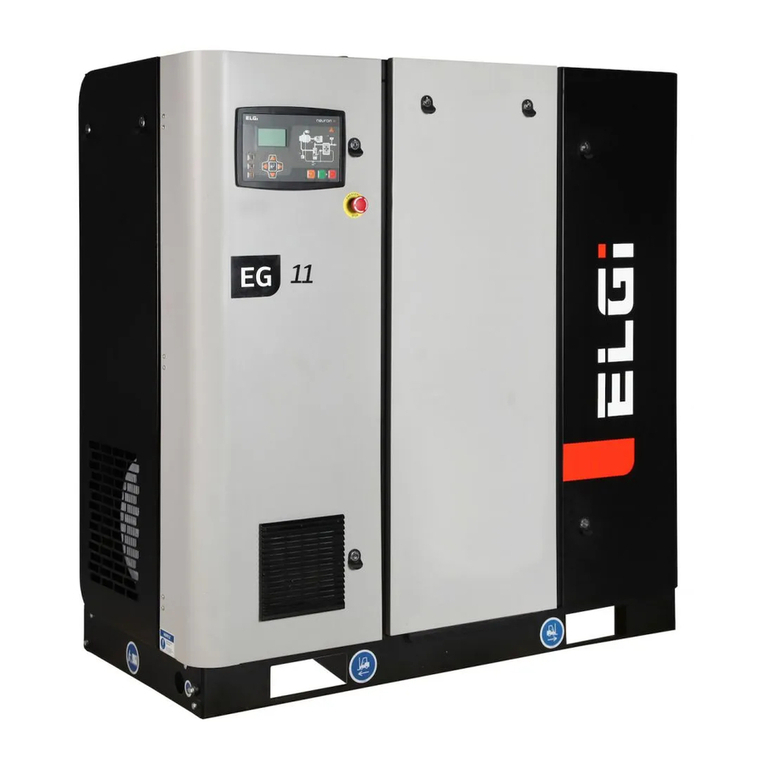
ELGi
ELGi EG Series Operation and maintenance manual
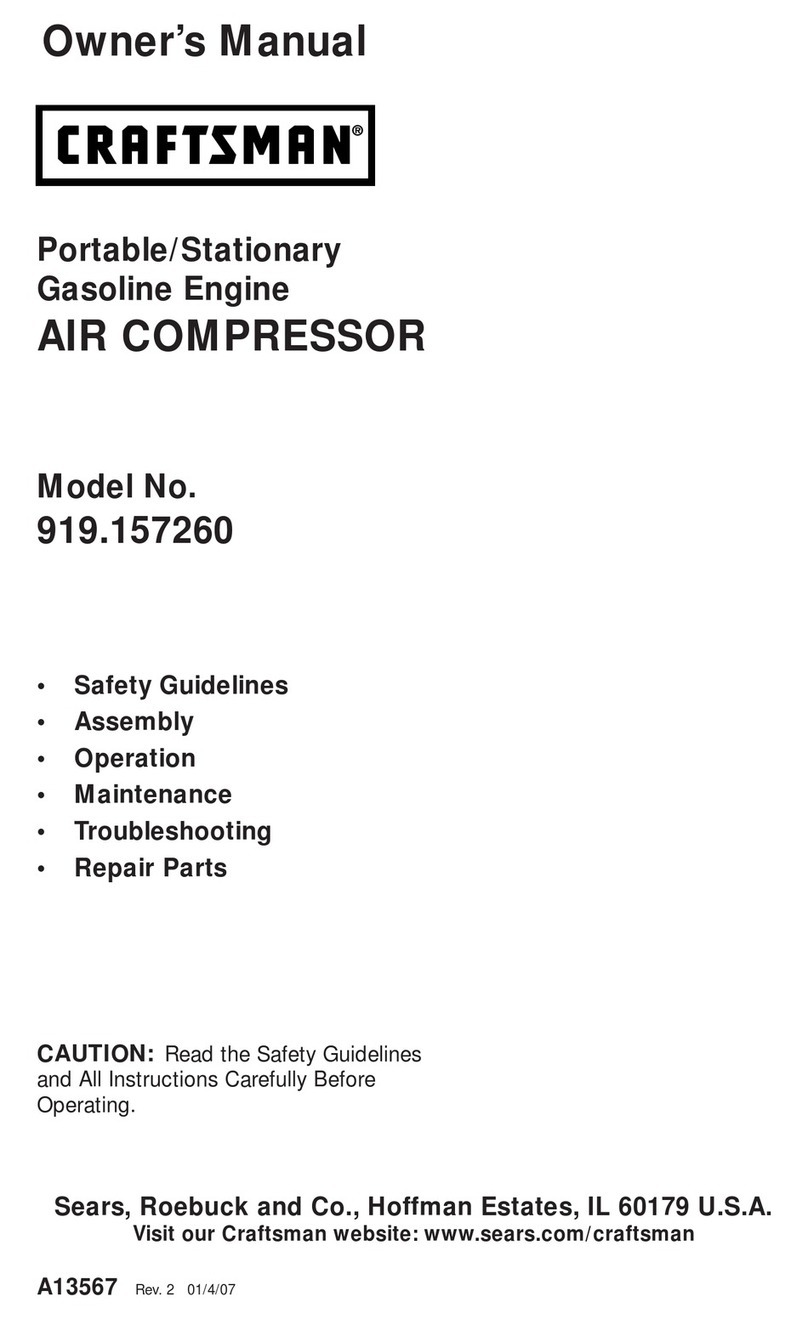
Craftsman
Craftsman 919.157260 owner's manual
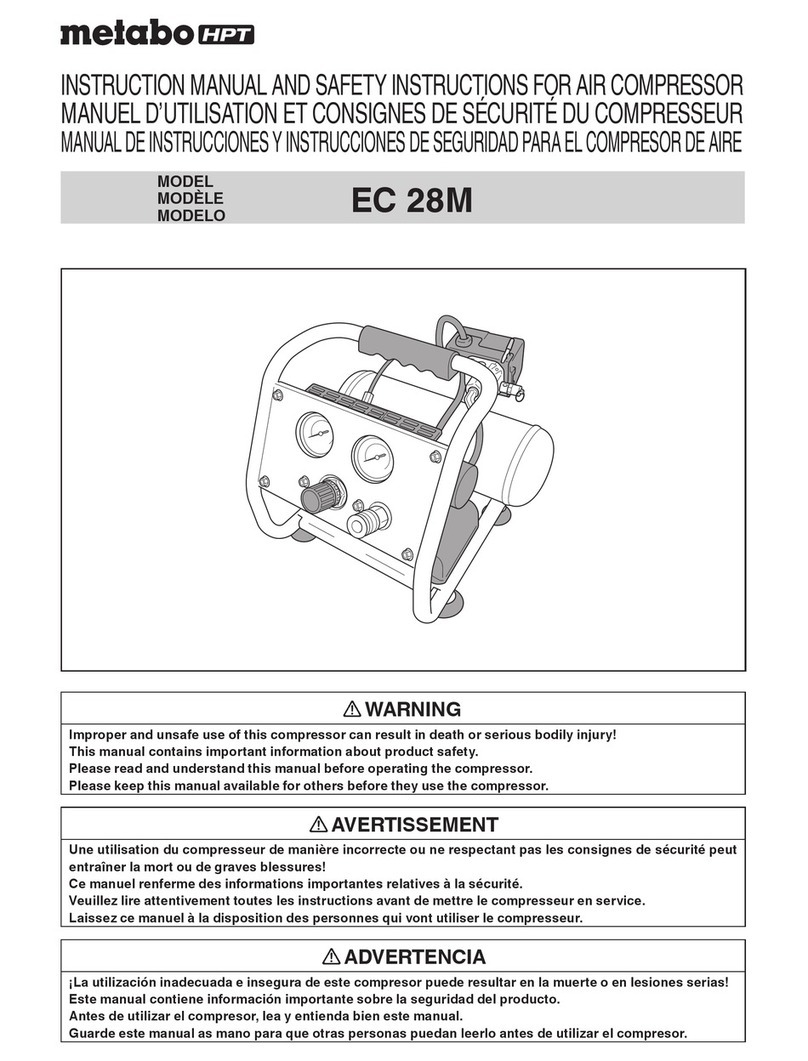
Metabo HPT
Metabo HPT EC28M Operating and installation instructions
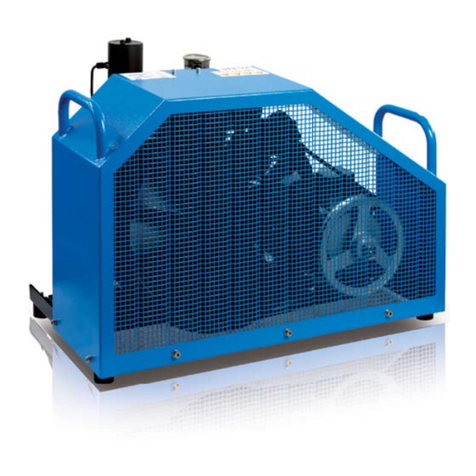
Coltri Compressors
Coltri Compressors MCH-8 EM STANDART Use and maintenance manual
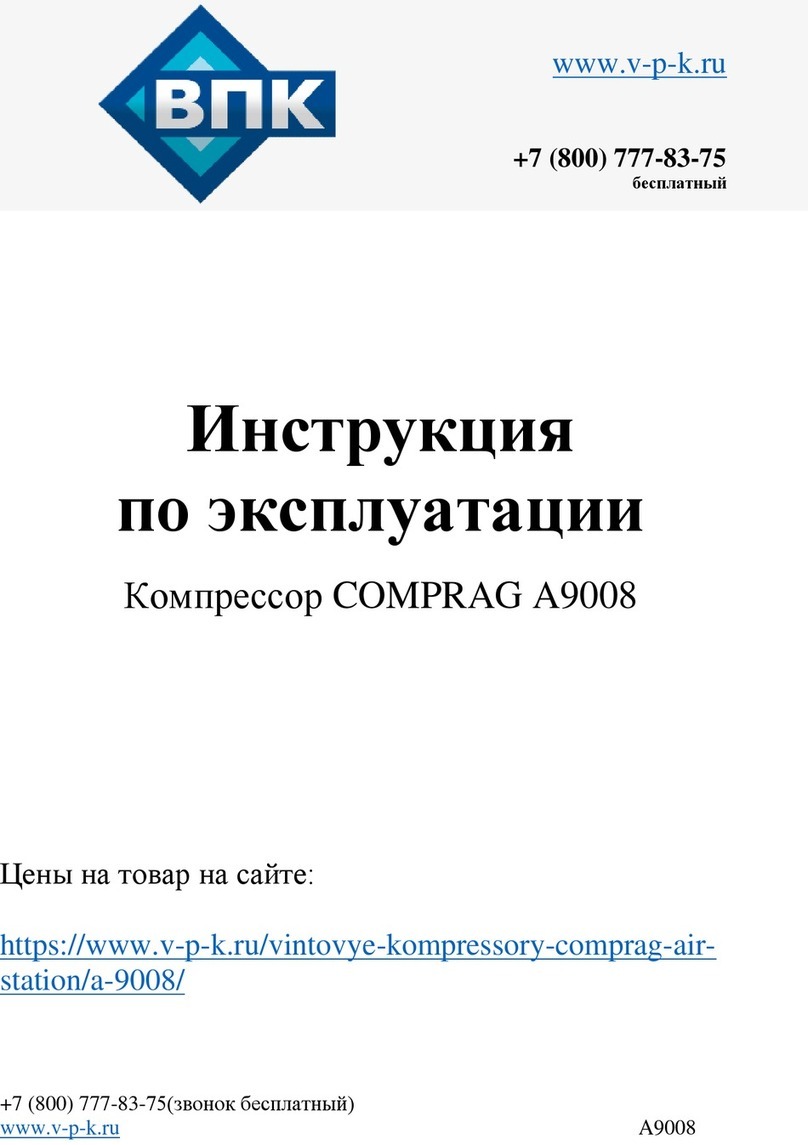
Comprag
Comprag A9008 manual
